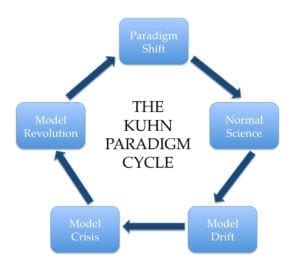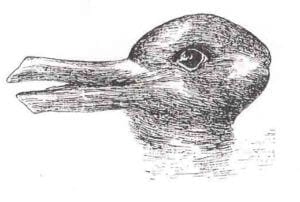Alexander Adams
Philadelphia, Pennsylvania, United States

Thomas Kuhn caused a major paradigm shift in the philosophy of science. Kuhn theorized that scientific progress is non-linear and occurs through periods in which science operates under the same focus, equipment, terminology, empirical methodology, and usually time period. He defines this framework of knowledge as a “paradigm”, where scientists try to answer questions during a period he calls “normal science”. Although Kuhn’s theory is stimulating for philosophical debate, there are limitations to his theory of scientific progress. These limitations include: the revisionist nature of history, non-scientific prejudices that dictate “normal science”, and examples of scientific progress that serve as exceptions to Kuhn’s paradigm model.
German philosopher Georg Wilhelm Friedrich Hegel stated “World History is a tribunal that judges the World” 1 in his Lectures on the Philosophy of World History. The quote suggests history is a subjective account written by those in power, and it coincides with a major flaw in Kuhn’s theory of scientific progress, in that it is based on the most popular and well-noted scientific achievements of his day. There are many scientific achievements that disrupt Kuhn’s over-simplified theory of paradigm progression, and Kuhn’s critics, such as philosopher Arun Bala, accuse him of Eurocentrism, possibly substantiated by Kuhn’s own writing:
“[O]nly the civilizations that descend from Hellenic Greece have possessed more than the most rudimentary science. The bulk of scientific knowledge is a product of Europe…No other place and time has supported the very special communities from which scientific productivity comes.”2
Bala’s 2006 book The Dialogue of Civilizations in the Birth of Modern Science outlines many examples of non-European scientific achievement, including the mathematical method of parabolic curve integration. This method is historically attributed to Frenchman Pierre de Fermat in 1629, which many feel “lacked epistemological basis”, as the same formulation appeared much earlier in Indian mathematician Jyesthadeva’s Yuktibhasa.3
Another example of scientific achievement outside of Kuhn’s paradigms is Chinese astronomy and time-keeping, which first originated around 1600 BC and resulted in lunar calendar technology being used as early as 1200 BC. Ancient Chinese astronomers independently predicted solar eclipses as accurately as within twenty-five minutes, predictions which NASA and Caltech’s Jet Propulsion Laboratories have even recently used.4 This level of astronomy arose independently and prior to the similar astronomical advancements spearheaded by Greek Ptolemy during the 2nd century, and Copernicus during the European Renaissance in early 1500’s, which Kuhn extensively describes as separate astronomical paradigms centered on geocentrism and heliocentrism, respectively. Mathematical advancements such as these are crucial to modern physics, and yet they appear to have emerged outside of Kuhn’s historical progression of paradigms.
A more modern example of a scientist ahead of his times and “paradigm” is Croatian physicist and electrical/mechanical engineer Nikola Tesla, who lived from 1856 to 1943. What is most interesting about Tesla is the mystery still surrounding him, including his dream of wireless power. Toward the end of his life, Tesla conducted a series of strange experiments in Colorado Springs and New York, yet many of his findings never surfaced. Tesla had ideas relevant to present and future science, such as: illuminating the stratosphere with energy to control daylight and weather; linking people globally with a “world system” of wireless communication akin to modern internet; and his infamous charged-particle “peace beam” weapon, which Tesla claimed could bring down a fleet of 10,000 planes 250 miles away and captured the attention of both the Soviets and Americans later during the Cold War. He accurately envisioned scientific advancements including radar, remote warfare, and even a flying vehicle reminiscent of today’s vertical short takeoff and landing military plane.5 However, his ideas did not cause what Kuhn considers to be a paradigm shift and were not widely distributed until after his death. Furthermore, Maxwell’s later theories of electromagnetism publicized in the 1960’s, which shared similarities with Tesla’s theories, were characterized by Kuhn as a paradigm shift, despite Tesla’s earlier work.2
An important part of Tesla’s obscurity resulted from an unfounded public prejudice against his eccentric personality and immigrant identity, and from Thomas Edison’s public smear campaign of Tesla as an industry competitor. Like Tesla, there exist numerous other examples of non-scientific suppression of scientific development, such as the Galileo Affair of 1610 and the Scopes Trial of 1925. The former consisted of Galileo’s trials before the Catholic Church’s Roman Inquisition for his support of Copernican astronomy, which resulted in his life sentence of house arrest and the banning of various scientific texts.6 The latter involved the successful criminal prosecution of a Tennessee high school teacher for teaching evolution to his students, resulting in a fine, immense publicity, and passing of anti-evolution laws in neighboring areas.7
Kuhn does discuss crises of revolutionary science where legitimate paradigms compete for supremacy, and also the “pre-paradigm period…marked by frequent and deep debates over legitimate methods, problems, and standards of solution”.2 However, his theory fails to address situations such as these, where non-scientific powers suppress successful science not for reasons of legitimate debate or incommensurability, but for unfounded prejudices, ethics, and rituals. Situations such as these have an immense influence on scientific progression, yet Kuhn’s theory fails to acknowledge their role, instead framing scientific progress as a wholesome debate between two scientific theories.
Kuhn deems science as “puzzle solving”, or answering cumulative questions under a similar heading.8 During Kuhn’s “normal science”, questions that cannot be answered are called anomalies and are initially neglected to focus on other answerable questions. Once nearly all the paradigm’s questions have been answered, scientists must focus on the anomaly. This intense, accumulating bewilderment makes the anomaly a “crisis”, which is when the “discipline begins to focus inordinately on the anomaly.”8 The crisis sometimes resolves with a “revolution”, where a new paradigm is formulated that turns the old paradigm upside down, such as Einstein’s relativity paradigm in physics.8 Kuhn calls this period of conflict between the old and new, “revolutionary science”, and if the new paradigm wins it becomes the new standard via “paradigm shift”.
Kuhn believes the paradigms are incommensurable, even though they may provide different explanations of the same phenomenon, such as the different definitions of mass in Einsteinian versus Newtonian physics. Incommensurability, for Kuhn, asserts that there are differences between paradigms that cannot be reconciled verbally or logically in a sequential fashion. One can only gain understanding through a random, irrational epiphany called a “revolution”, which Rosenberg equilibrates to a Gestalt switch, where one suddenly sees something in an entirely new light, like the famous illusion in Figure 2 that Kuhn references.
In reality, all of science does not operate this way. Scientific revolutions that completely shift the paradigm like Einstein’s theory of relativity from Newtonian physics are built on years and years of assertions made before them. Today, both “paradigms” are taught in schools at a young age. Obviously, there exists a huge capability for translating and understanding of these paradigms, the theories and technology they were based on, and the timeline of scientific “truths” that preceded those paradigms and came afterward. If there was not, these paradigms would not be taught and tested in schools, and students would not be able to articulate their distinct understanding of each paradigm. Even if one does adhere to Kuhn’s theory, the creation of a new paradigm is dependent on the anomaly of the previous one, inherently linking them.
In addition, the model of scientific theory-change that Kuhn puts forth does not apply to the progress in all of science, as it seems to with physics paradigms. For example, the progress observed in biology is more accumulative in nature than “paradigm-like”. Biology has progressed from gross anatomy to histology to biochemistry, and the academic approach to this reduction of biology has retained the same goal of connecting structure and function through empirical observations. Despite these areas sharing similarities, they operate independently as fields with their own terminology and techniques, and so cannot necessarily be considered the same paradigm. Another example in biology is the progression of Darwinian evolution based on inherited physical traits, to Mendelian genetics that discussed the concept of a gene causing that physical trait, to modern genetics based on sequencing data and complex biochemical phenomena of nucleic acids within cell nuclei.
Despite a common association of these accumulative developments, each one functions independently as a scientific model of explanation. The notion of incommensurability is purely subjective based on one’s ability to understand or connect knowledge progression over the years. One could argue that Kuhn’s example of phlogiston chemistry’s explanation for fire, in which certain materials contain a capacity for flammability through “phlogiston”, is not purely incommensurable with modern chemistry’s explanation, as he suggests.2 In this regard, the phlogiston theory may serve as a prelude to modern oxidation-reduction theory, where certain materials are highly reduced with electrons and have a capacity to donate those electrons through oxidation (often resulting in fire), if one only makes the connection.
In conclusion, despite having a compelling premise, the scientific progress theories of Thomas Kuhn contain limitations. These limitations include: a failure to account for historical scientific advancements that occur outside of their supposed “paradigm”; a failure to explain additional factors that affect scientific progression, such as irrational oppression of science by non-scientific powers; and an inability to be applied universally to every field, outside of Kuhn’s favored physics examples. Through the digital revolution of the twenty-first century, the nature of scientific progress will continue to be unraveled, which will bring along with it additional implications to the fascinating philosophy of science put forth by Thomas Kuhn.

Bibliography
- Hegel, Georg Wilhelm Friedrich. Lectures on the philosophy of world history: introduction, reason in history (translated from the German edition of Johannes Hoffmeister from Hegel papers assembled by H. B. Nisbet). New York, NY: Cambridge University Press, 1975.
- Kuhn, Thomas S. The Structures of Scientific Revolutions. Chicago, IL: University of Chicago Press, 2012.
- Bala, Arun. The Dialogue of Civilizations in the Birth of Modern Science. New York, NY: Palgrave Macmillan, 2006.
- PlanetQuest: The History of Astronomy. “Early Chinese Astronomy.” Last modified 2005, accessed March 20, 2016. http://www.planetquest.org/learn/chinese.html.
- PBS. “Tesla: Life and Legacy.” Last modified 2013, accessed March 20, 2016. http://www.pbs.org/tesla/index.html.
- Heilbron, John L. “Censorship of Astronomy in Italy after Galileo.” In The Church and Galileo, edited by McMullin and Ernan.Notre Dame, IN: University of Notre Dame Press, 2005.
- Decamp, Sprague. The Great Monkey Trial. Garden State, NY: Doubleday Inc., 1968.
- Rosenberg, Alex. Philosophy of Science. New York, NY: Routledge, 2005.
- Figure 1: Adams, Alexander. Based on the philosophical model outlined in: Kuhn, Thomas S. The Structures of Scientific Revolutions. Chicago, IL: University of Chicago Press, 2012.
- Figure 2: Jastrow, J. “The mind’s eye.” Popular Science Monthly 54 (1899): 299-312. Accessed March 20, 2016. http://socrates.berkeley.edu/~kihlstrm/JastrowDuck.htm
ALEXANDER J. ADAMS is a third-year medical student at Sidney Kimmel Medical College at Thomas Jefferson University in Philadelphia, PA. Prior to medical school, Alexander earned his Bachelor of Science in Human Science with a minor in Chemistry achieving magna cum laude distinction at Georgetown University in Washington, DC. Alexander maintains an avid interest in the philosophy of science and medical humanities, and he has held related roles including Chapter President of Georgetown University’s Alpha Sigma Nu, a National Jesuit Honors Society, and is a member of Thomas Jefferson University’s College within the College Clinical-Translational Research Program.

Leave a Reply